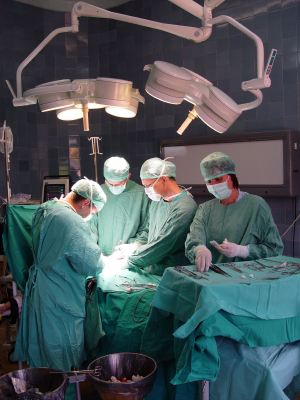Safe and Risky Hospitals Have Same Number of Post-Op Complications
by
Brendon Nafziger, DOTmed News Associate Editor | October 23, 2009

Response to surgical
complications varies by hospital
What makes a hospital safe for surgeries? According to surprising new research, it's not how likely you are to suffer a life-threatening complication following an operation. Rather, it's what the hospital does afterward that matters.
In a study published this month in the New England Journal of Medicine, doctors discovered that hospitals with the fewest surgical deaths had the same number of post-op complications, such as heart failure, deep wound infection or pneumonia, as ones with the most deaths: around one out of six surgeries led to complications in all hospitals included in the study.
What instead separated the safest from the riskiest hospitals was what the staff did next.
"We looked at something called failure to rescue," Amir Ghaferi, M.D., the author of the study and a research fellow in the surgical department at the University of Michigan's medical center in Ann Arbor, tells DOTmed News. Failure to rescue is a medical term meaning death following a major complication, such as stroke.
And it turns out that hospitals with the highest mortality rates were somehow worse at rescuing their patients from such complications.
"Inherent in [this finding], is what a hospital does to even recognize or manage a complication efficiently," Dr. Ghaferi says.
For the study, the doctors trawled a database containing records of around 85,000 patients who had undergone surgery at hospitals around the country. They then ranked the hospitals into five groups based on their risk-adjusted mortality rates, i.e. how likely their patients were to die after controlling for patient health, age, type of procedure and other factors.
The doctors found that though the risk of a major, life-threatening complication following surgery was about the same (less than 20 percent) in the highest and lowest ranked hospitals, those going under the knife at a high-risk health center were twice as likely to die.
The study wasn't designed to find out why there were differences in failure-to-rescue rates among hospitals, but Dr. Ghaferi says both the existing medical literature and some early back-of-the-envelope analysis all suggest the answers lie in hospital administration, not doctor quality.
"All signs are pointing away from the surgery itself as far as rescue rates," he says. "Resources and hospital structure and characteristics are what really drive this."
Possible candidates for reducing post-surgical patient mortality are a high nurse-to-bed ratio, good nurse job satisfaction, availability of high-tech equipment like CT and MRI scanners and hospital size -- the larger, the better, it seems.
Being a teaching hospital also appears to help. Round-the-clock presence of residents could mean there are more eyes looking out for problems as soon as they arise.
